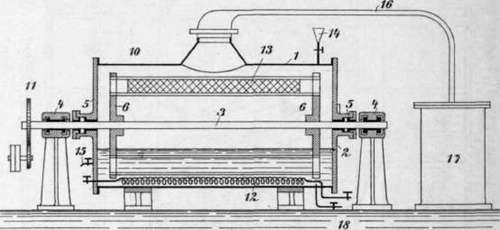Description Of Garmier's Apparatus For The Extraction Of Flowers
Description
This section is from the book "The Volatile Oils Vol1", by E. Gildemeister. Also available from Amazon: The Volatile Oils.
Description Of Garmier's Apparatus For The Extraction Of Flowers
Figures 58 to 60 illustrate an apparatus constructed by Gamier1) for the extraction of flowers. It consists of a stationary outer cylinder, (figs. 58 and 59) which at 2 is provided with a manhole that can be hermetically sealed. Within there is a drum that revolves about the shaft 3 (fig. 58), that passes through the outer cylinder at 5 and rests upon supports at 4.
The end pieces of the inner drum has twelve circular openings 7 near the circumference (fig. 60). Each of these openings is connected with the corresponding one at the opposite end of the drum by means of a circle of rods which effect a hollow cylinder. Into these hollow cylinders, of which each drum has twelve, cylindrical baskets 13 of perforated tin can be placed (fig. 58).

Fig. 58. Longitudinal section of Garnier's extraction apparatus.

Fig. 59. Transverse section of Garnier's extraction apparatus.

Fig. 60.Transverse section of the inner drum of Garnier's extraction apparatus.
The power which is transmittet by cogwheels at // put the drum into rotary motion. By means of a spiral tube 12 the liquid in the outer cylinder can be gently heated. The tube 16 connects the apparatus with a condenser 17, hence it can be used as a still.
Operation begins by introducing the cylindrical baskets 13 filled with flowers, through the man hole 2 (fig. 59) into the drum. Enough solvent, petroleum ether, is then introduced through the funnel 14 (fig. 58) so that the lowest flower basket is completely covered thereby. The drum being revolved causes the baskets one after the other to be dipped into the solvent. The flowers having been exhausted, the extract is withdrawn by means of a stopcock 18. Steam is then passed through the apparatus in order to recover any solvent adhering to the flowers.
1) Comp. p. 249.
Continue to:


